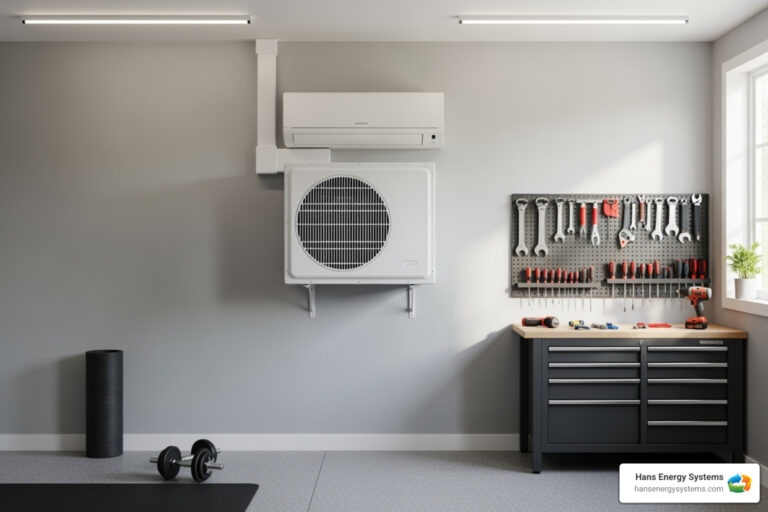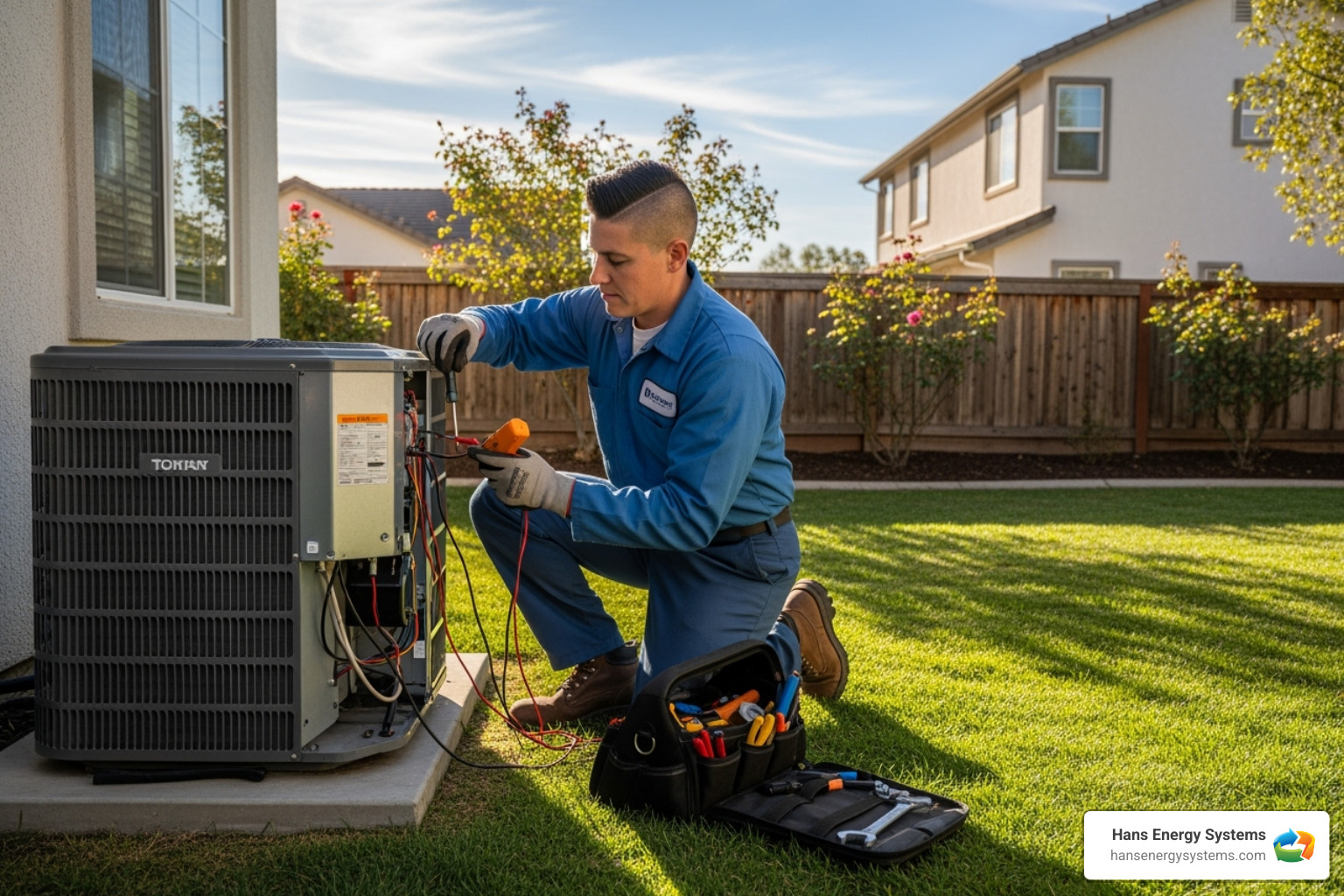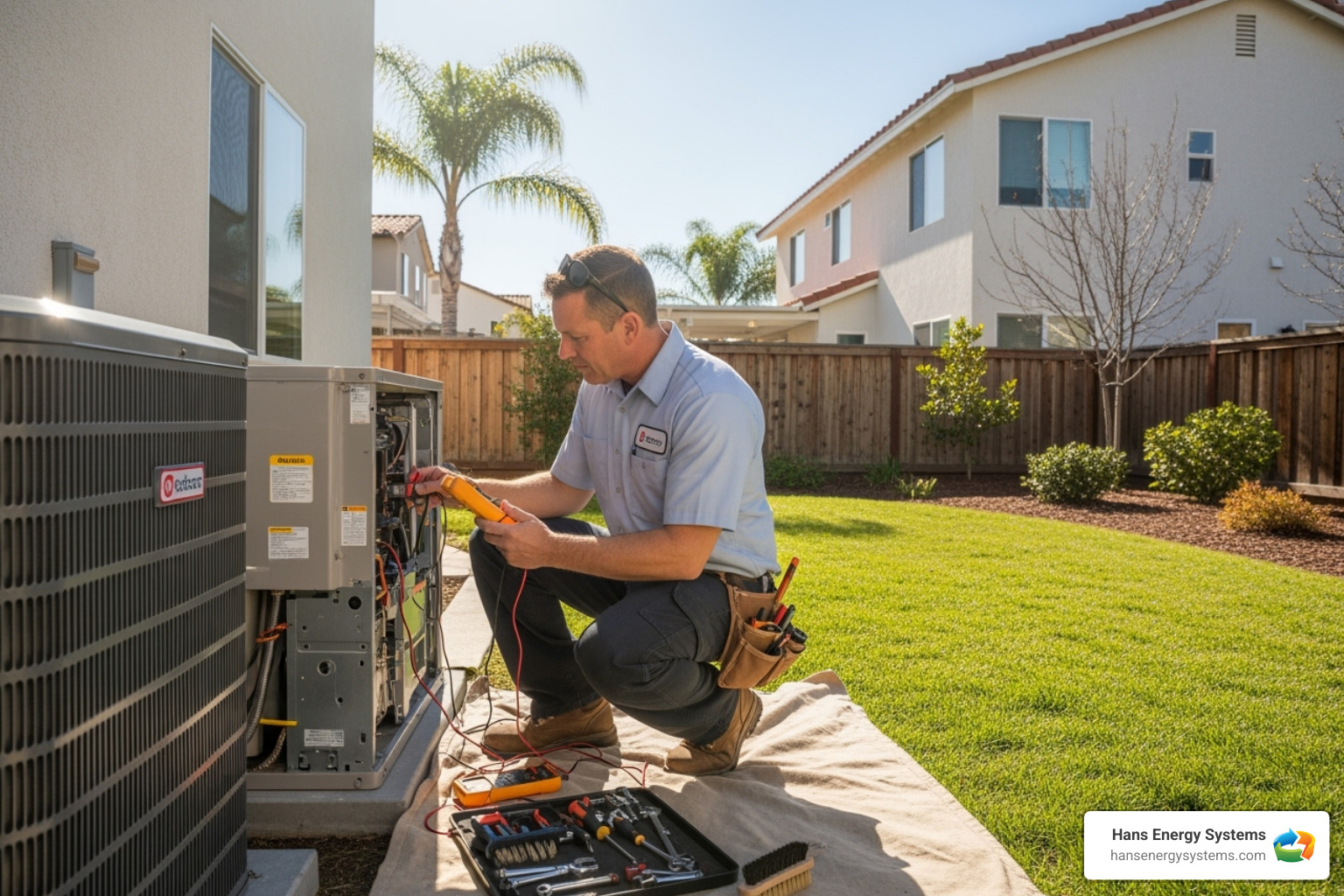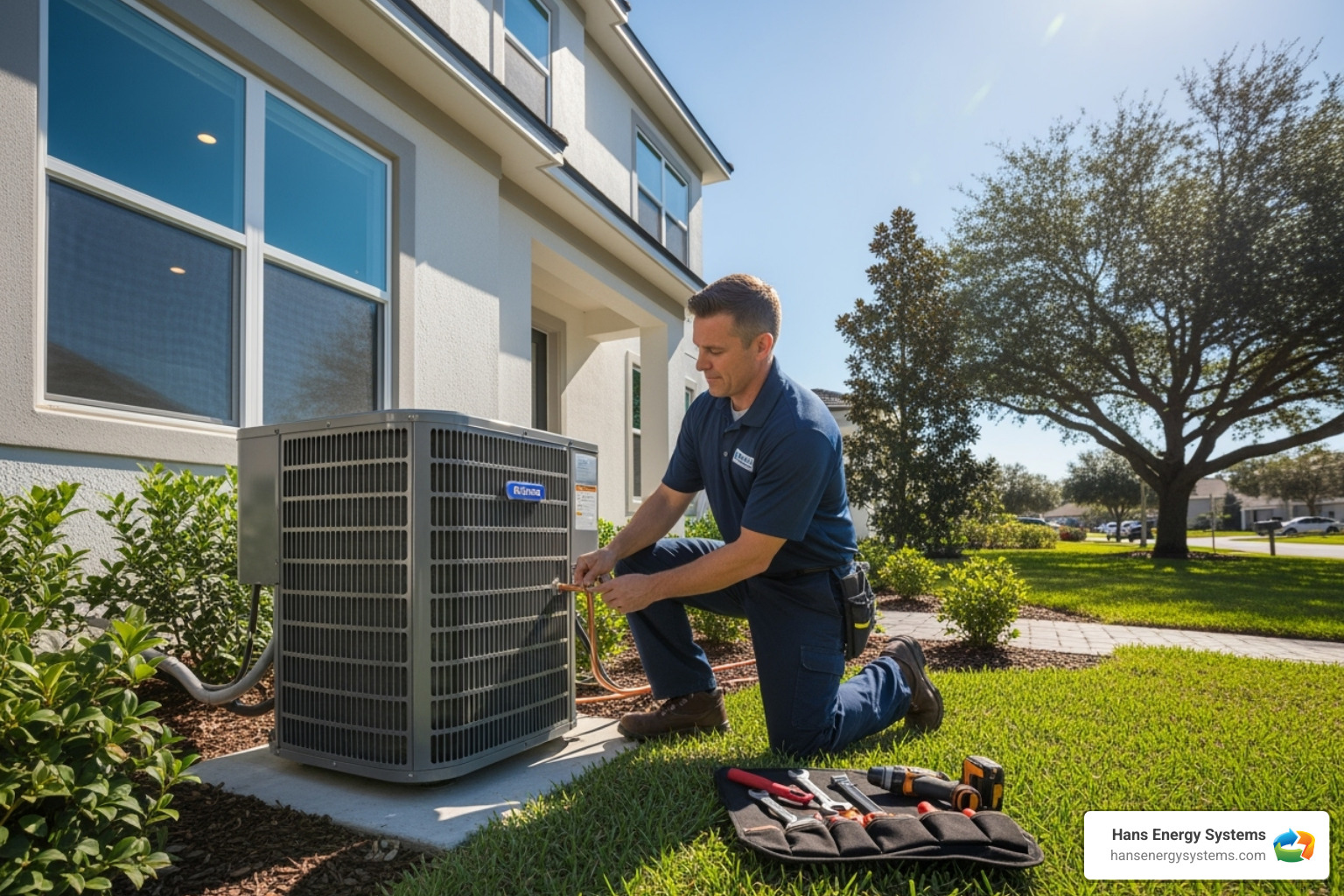The Smart Way to Climate Control Your Garage
Today’s garages are much more than carports or storage spaces. Many homeowners are changing them into workshops, home gyms, or even extra living areas. To make these spaces truly usable all year, you need good heating and cooling. A garage mini split system offers an ideal solution.
Here’s why a mini split is a smart choice for your garage:
- Year-round comfort. It provides both heating and cooling for any season.
- Energy efficiency. It uses less energy than many other heating and cooling options.
- Customized control. You can set the garage temperature independently from your main house.
- Quiet operation. Enjoy your garage space without loud, distracting noise.
- Expanded usable space. It helps turn an often-unused garage into a comfortable, functional room.
Mini splits can make your garage comfortable and functional, no matter the weather outside. They offer a modern answer to an old problem.
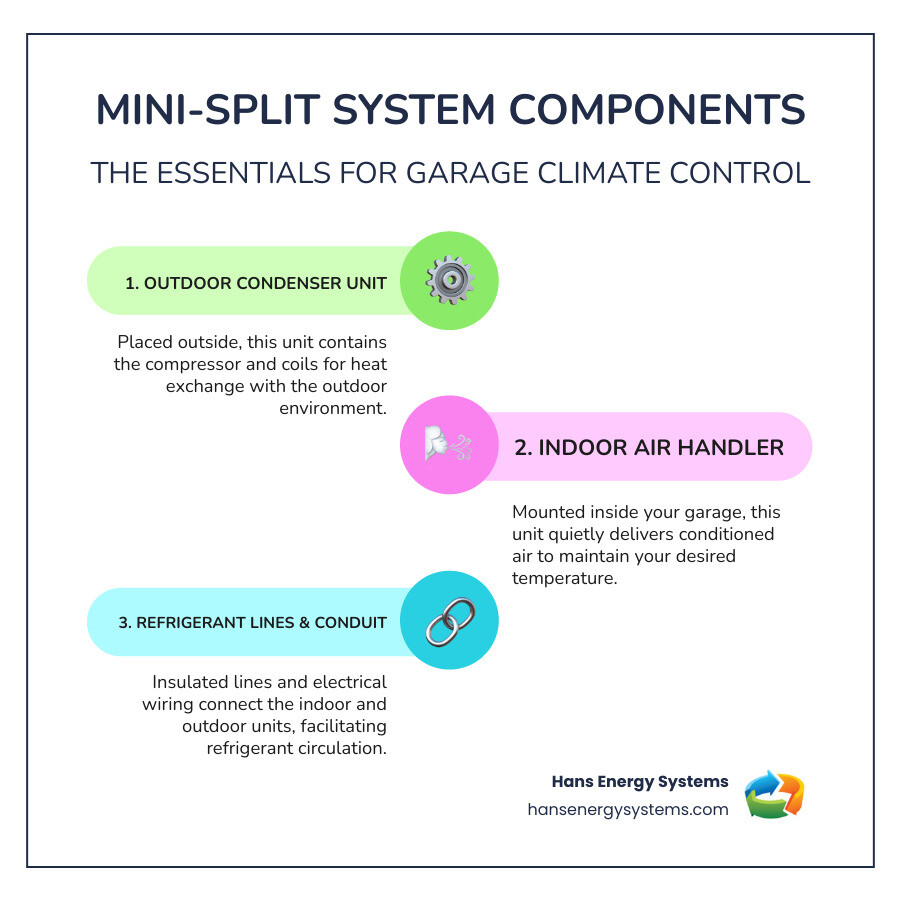
Why a Mini Split is the Ideal Climate Solution for Your Garage
We’ve seen garages evolve from simple parking spots to extensions of our homes—becoming vibrant workshops, quiet home offices, or energetic gyms. To truly open up the potential of your garage, consistent and comfortable climate control is essential. This is where a garage mini split shines, offering a custom solution that traditional HVAC systems often can’t match.
The Best Benefits
Choosing a garage mini split brings a host of advantages that make your garage a truly usable space all year long.
- Year-Round Comfort and Use: Unlike systems that only cool or only heat, mini splits offer both, ensuring your garage is comfortable whether it’s the peak of summer or the depths of winter. This allows you to use your garage for hobbies, workouts, or work, regardless of the outside temperature.
- Increased Home Value: Changing an unconditioned garage into a functional, comfortable space adds tangible value to your home. It’s like gaining an extra room without the extensive renovation costs of a traditional addition.
- Superior Energy Efficiency: Mini splits are renowned for their energy efficiency. They use inverter technology, which allows the compressor to adjust its speed to meet the exact heating or cooling needs, rather than cycling on and off. This “low-and-slow” approach means they use less electricity, leading to lower energy bills. In fact, mini-split systems can be up to 300% more efficient than traditional HVAC systems. This efficiency is especially noticeable because mini splits don’t suffer from energy losses associated with ductwork, which the U.S. Department of Energy notes can account for more than 30% of energy consumption for space conditioning in central air systems.
- Effective Dehumidification: Beyond just temperature control, mini splits are excellent at managing humidity. During cooling cycles, their inverter technology allows them to run longer cycles at lower fan speeds, which is highly effective at removing moisture from the air. This is crucial for comfort and for protecting stored items like electronics and tools from dampness and corrosion.
- Precise Temperature Control: With a mini split, you get precise control over your garage’s temperature, independent of your main home’s thermostat. This means you can keep your garage at a comfortable 72°F while the rest of your house is set differently, or even turn it off completely when not in use to save energy.
- Quiet Performance: The indoor units of mini splits are designed for quiet operation, often as low as 22dB(A), which is barely a whisper. The loudest components are housed in the outdoor unit, further minimizing noise inside your garage. This allows for a peaceful environment, whether you’re concentrating on a project or enjoying a workout.
With proper maintenance, a mini split unit can last up to 20 years or more, providing long-term comfort and value. To learn more about how these systems can benefit your home, explore our More info about Ductless AC services.
Why Mini Splits Outperform Other Garage Cooling and Heating Methods
When considering climate control for your garage, you might think about a few options. However, we’ve found that mini splits consistently outperform other alternatives due to their unique design and capabilities.
Limitations of Traditional Fans and Portable Heaters:
While affordable, traditional fans only circulate existing air, offering minimal cooling in hot conditions. Portable electric heaters can provide warmth, but they often struggle to heat a large, uninsulated garage effectively and can be energy inefficient. Neither offers true climate control or dehumidification.
Impracticality of Window Units in Garages:
Window AC units are noisy, unsightly, and often impractical for garages that may not have suitable windows or where security is a concern. They only provide cooling and offer no heating.
Challenges with Extending Existing Ductwork:
You might consider extending your home’s central HVAC ductwork into the garage. However, this is usually not the best option. Garages often have different insulation levels and air leakage compared to living spaces, making them difficult to condition with a system designed for a house. Extending ducts can lead to:
- Inefficient performance: Your central system might struggle to adequately heat or cool the garage without impacting the comfort of the main house.
- Increased energy bills: The added load on your central system can significantly increase energy consumption.
- High installation costs: Running new ductwork can be expensive and may require significant modifications to your existing HVAC system.
Here’s a quick comparison of how mini splits stack up against some less effective alternatives:
| Feature | Mini Split | Portable Fan/Heater | Window Unit | Extending Central Ductwork |
|---|---|---|---|---|
| Efficiency | High (inverter technology, no duct loss) | Low (ineffective or energy intensive) | Moderate (localized, but can be inefficient) | Low (strains central system, duct loss) |
| Installation | Relatively easy (no ducts, small footprint) | Plug-and-play | Requires window, often bulky | Complex, expensive, extensive modifications |
| Effectiveness | Precise, consistent heating & cooling | Limited air movement/spot heating | Localized cooling only | Often inadequate, creates hot/cold spots |
| Performance | Quiet, dehumidifies, year-round comfort | Noisy, no humidity control | Noisy, no humidity control, cooling only | Noisy, struggles with garage conditions |
| Versatility | Heating, cooling, dehumidification, independent | Single function | Single function (cooling) | Designed for main house, not ideal for garage |
As you can see, a garage mini split offers a comprehensive, efficient, and custom solution for your garage, making it the superior choice for comfort and functionality.
Key Considerations for Your Garage Mini Split
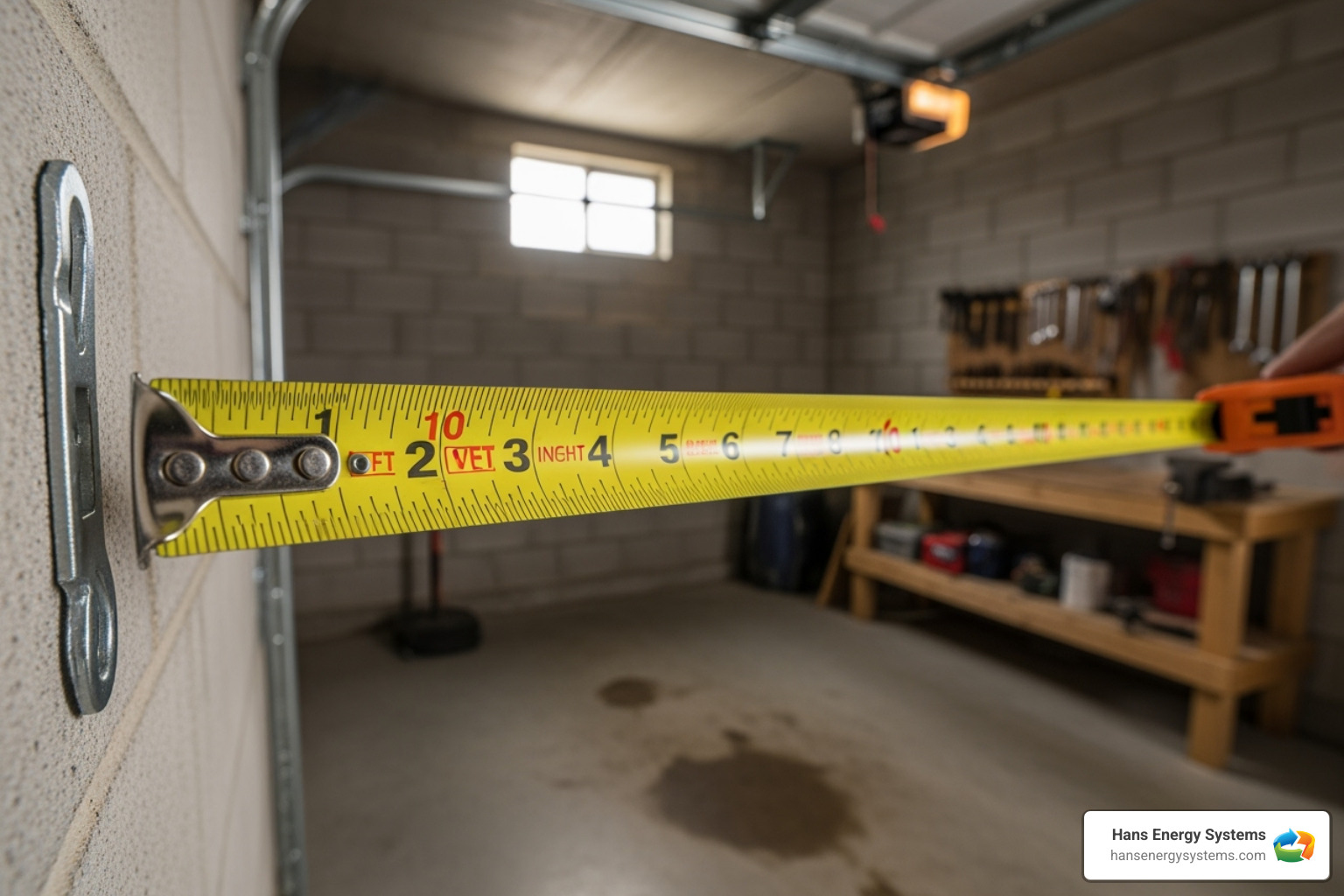
Choosing the right garage mini split isn’t just about picking a unit off the shelf. It requires careful consideration of several factors unique to garage environments. These elements directly impact the system’s performance, efficiency, and your overall comfort.
Sizing Your Garage Mini Split Correctly
The most critical step in selecting a garage mini split is proper sizing, measured in BTUs (British Thermal Units). An undersized unit won’t keep your garage comfortable, while an oversized one can lead to inefficient operation, short-cycling, and poor dehumidification.
Here’s what we consider:
- Square Footage: This is your starting point.
- A 9,000 BTU mini split can typically cool an area of 300-400 square feet. This is often sufficient for a one-car garage (around 400 sq. ft.).
- A 12,000 BTU unit can cool up to 500 square feet. This is typically needed for a two-car garage (around 500 sq. ft.).
- For a two-car garage (400-600 sq. ft.), a 12,000-18,000 BTU mini split is recommended.
- An 18,000 BTU unit may be beneficial for larger garages or those with higher ceilings, and a three-car garage might even require an 18,000 BTU capacity or two air handlers.
- Ceiling Height Calculation: Most garages have 8-9 foot ceilings, but some are higher or vaulted. The extra air volume requires more heating and cooling power. To adjust for a high ceiling, multiply your square footage by:
- 1.1 for 10-foot ceilings
- 1.2 for 11-foot ceilings
- 1.3 for 12-foot ceilings, and so on.
- Dangers of Oversizing: While more BTUs will cool down the space faster, an oversized unit cycles on and off too frequently (short-cycling). This wastes energy, doesn’t adequately remove humidity, and puts more wear and tear on the system, shortening its lifespan. Mini-splits work best when maintaining a set temperature over time on a low-and-slow mode.
Here’s a list of common garage sizes and typical BTU needs, serving as a general guideline:
- One-Car Garage (up to 400 sq. ft.): 9,000-12,000 BTU
- Two-Car Garage (400-600 sq. ft.): 12,000-18,000 BTU
- Three-Car Garage (600-800 sq. ft.): 18,000-24,000 BTU
These are general guidelines. A professional load calculation (like a Manual-J calculation) is the best way to determine the precise BTU requirements for your specific garage.
The Crucial Role of Insulation and Air Sealing
Garages are notoriously poorly insulated compared to the main living areas of a home. This significantly impacts the performance and efficiency of your garage mini split.
- Impact of Poor Insulation: If your garage walls, ceiling, or especially the garage door are uninsulated, conditioned air will quickly escape, and outside temperatures will seep in. This forces your mini split to work much harder, consuming more energy and struggling to maintain the desired temperature.
- Insulating Garage Doors: Garage doors are often the largest uninsulated surface. Investing in a garage door insulation kit (which can be relatively inexpensive) can make a huge difference in thermal performance.
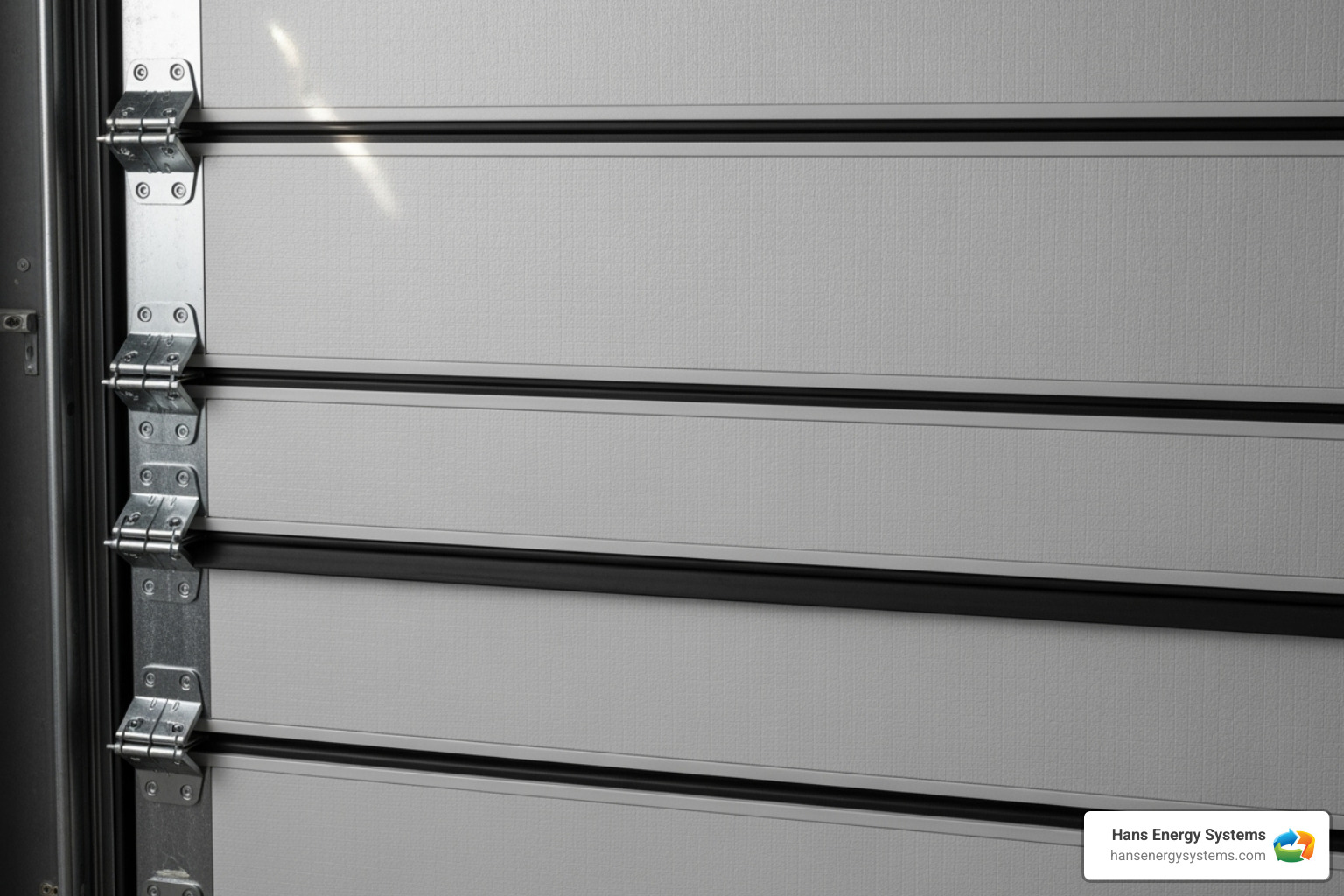
- Sealing Gaps and Cracks: Large gaps around garage doors, windows, and even small cracks in walls or around utility penetrations can lead to significant air leakage. Sealing these with weather stripping and caulk is a low-cost way to dramatically improve your garage’s energy efficiency.
- Upsizing for Poor Insulation: If insulating your garage isn’t feasible, we often recommend upsizing your mini-split system by at least one size to compensate for the lack of insulation. However, improving insulation is always the most cost-effective long-term solution.
Factoring in Climate and Garage Usage
The climate you live in and how you intend to use your garage are also vital in selecting the right garage mini split.
- San Diego Climate: In San Diego County, we experience hot summers and mild winters. While our winters are generally not extreme, having a mini split with reliable heating capabilities ensures year-round comfort. In extremely hot climates, good cooling capacity and dehumidification are paramount. Some sophisticated units can even provide heat down to -22℉ outside, though this might be overkill for our local climate.
- Workshop Heat Generation: Will you be using equipment that generates significant heat, like welding machines, kilns, or powerful woodworking tools? If so, this added heat load needs to be factored into your BTU calculations. For example, a kiln can add 5000 BTUs of heat per hour!
- Home Gym Occupancy: If your garage doubles as a home gym or a space for gatherings, the body heat from occupants can significantly increase the cooling load. A group of 15 people can generate approximately 6000 BTUs of heat per hour (400 BTU per person).
- 110v vs. 220v Efficiency: For garage mini split applications, we generally recommend 220V (or 240V) units over 110V (or 120V) models. A 240V mini-split is generally more efficient than a 120V mini-split. While 110V units might seem convenient if you want to avoid running a new dedicated circuit, they are often less efficient and may not perform as well, especially in larger spaces or during peak demand. Dedicated circuits are recommended for all mini-split installations, regardless of voltage.
Installation and Maintenance Essentials
Once you’ve chosen the perfect garage mini split system, the journey isn’t quite over. For it to truly deliver all the comfort and efficiency you’re looking for, proper installation and ongoing, simple maintenance are absolutely key. Think of it as setting your system up for a long, happy life!
Professional Installation for a Garage Mini Split
While you might see some garage mini split systems advertised as “DIY-friendly,” trust us, when it comes to something as important as your home’s climate control, professional installation is always the smarter choice. Here’s why a pro should handle the job:
First, your mini split needs a dedicated electrical circuit. This is a safety measure to ensure the unit gets enough power without overloading your home’s electrical system. Running new wiring or upgrading your electrical panel is a job for a licensed electrician, not a weekend warrior!
Then there’s the tricky business of refrigerant handling. Mini splits use special coolants, and these aren’t chemicals you want to mess with. They require specific tools, training, and certifications to handle safely and correctly. Improper handling can lead to leaks, harm the environment, and even cause your brand-new system to fail. Not a fun surprise!
Optimal unit placement is another big one. Where your indoor and outdoor units sit can make a huge difference in how well your system works and how much energy it uses. For the indoor unit, we usually recommend placing it about 6 feet or more above the floor and at least 6 inches below the ceiling. This allows for the best airflow. If your garage walls are already full of shelving or that big automatic garage door, a ceiling- or even a floor-mounted unit might be a better fit to use your space wisely. The outdoor unit (the condenser) also needs plenty of space for airflow and should be placed on a stable, level surface, like a concrete pad. We also make sure to protect it from direct sunlight and debris.
A professional installer ensures everything is connected perfectly, from the refrigerant lines to the electrical wiring. This precision means your system will run at its best, save you money on energy bills, and last for many years. Plus, proper installation often keeps your warranty valid. Many manufacturers won’t honor warranties if the system wasn’t installed by a certified professional. Oh, and one more thing: most areas require permits for HVAC installations. A professional will know the local rules and handle all the paperwork, so you don’t have to worry about compliance.
For top-quality installation of your garage mini split system right here in San Diego County, including Poway, CA, our team at Hans Energy Systems provides reliable, professional work. You can find more Details on professional AC Installation in Poway, CA on our website.
Simple Maintenance for Long-Term Performance
Once your garage mini split is professionally installed, keeping it running smoothly is surprisingly easy. Mini splits are built to be durable and pretty low-maintenance, but like any hardworking appliance, they love a little care. With good maintenance, your mini split can happily serve you for 15 to 20 years or even longer!
The easiest and most important thing you can do yourself is cleaning the filters. The indoor unit has filters that catch dust and debris. We recommend cleaning them every few months. If your garage is a busy workshop or gets dusty often, you might need to clean them more frequently. Clean filters mean better airflow, more efficiency, and cleaner air for you!
You should also periodically check the outdoor unit. Just take a quick look to make sure no leaves, dirt, or grass clippings are blocking the coils. Keeping the area around it clear helps it breathe.
Beyond these simple DIY tasks, we strongly recommend scheduling an annual professional tune-up. During this yearly check-up, our skilled technicians will go through your system with a fine-tooth comb. They’ll check refrigerant levels, inspect all electrical connections, clean coils and other components, and test everything to make sure your garage mini split is running perfectly. This routine check helps catch any small issues before they turn into big, expensive problems.
Regular maintenance isn’t just about avoiding breakdowns; it ensures your garage mini split operates at its peak efficiency, saving you money on energy bills and truly extending its lifespan. To make maintenance a breeze, consider our Information on our HVAC Maintenance Plan in Poway, CA.
Frequently Asked Questions about Garage Mini Splits
When homeowners start thinking about adding climate control to their garage, we get lots of great questions. Let’s tackle the most common ones we hear from folks just like you.
Can a mini split provide both heating and cooling for a garage?
Yes, absolutely! This is one of the best features of a garage mini split system. You’re getting two systems in one, which is pretty amazing when you think about it.
The magic happens through heat pump technology. Your mini split doesn’t actually create heat or cold—it moves heat around. During summer, it pulls heat from inside your garage and dumps it outside, keeping you cool. When winter rolls around, it flips the process using something called a reversing valve. Even when it’s chilly outside, there’s still heat in the air (hard to believe, but true!), and your mini split can extract that heat and bring it inside to warm your garage.
This year-round comfort means you can use your garage workshop in January or work out in your garage gym during a July heat wave. No need for separate heating and cooling systems—your mini split handles it all with efficient heating and cooling performance.
How long does a garage mini split last?
Here’s some good news: a garage mini split is built to go the distance. With proper care, you’re looking at a typical lifespan of 15-20 years, and some systems can even push beyond that.
The key to reaching that 20-year mark? Regular maintenance. Think of it like your car—change the oil regularly, and it’ll serve you well for years. For your mini split, this means cleaning those filters every few months (seriously, it takes about five minutes) and having a professional check it over once a year.
Professional servicing makes a huge difference in longevity. During annual tune-ups, technicians catch small issues before they become big, expensive problems. They’ll check refrigerant levels, clean coils, and make sure everything’s running smoothly. It’s a small investment that can add years to your system’s life.
We’ve seen well-maintained units still running strong after two decades, while neglected ones start having problems after just a few years. The choice is yours!
Is a single-zone or multi-zone system better for a garage?
For most garage setups, a single-zone system is your best bet. It’s simpler, more affordable, and gives you exactly what you need—independent control of your garage’s temperature without affecting the rest of your house.
A single-zone garage mini split consists of one outdoor unit connected to one indoor unit. Perfect for that typical one-car or two-car garage where you want consistent temperature throughout the space.
When to consider multi-zone systems? There are a few specific situations where it might make sense. If you have a large or L-shaped garage where one unit might struggle to reach every corner effectively, multiple indoor units could provide better coverage. Some folks with massive three-car garages or workshops with separate office areas find multi-zone systems helpful for creating different comfort zones.
But honestly, for the average garage—even a good-sized two-car space—a single-zone system provides plenty of power and performance. You’ll get that independent control you want without the added complexity of managing multiple zones. Keep it simple, and you’ll be happier with the results.
Transform Your Garage with the Right Climate Control
We hope this guide has given you a clear picture of just how amazing a garage mini split system can be! It’s not just about making a space warmer or cooler; it’s about open uping the full potential of your garage. Imagine finally having that comfortable workshop you’ve always dreamed of, a welcoming home gym, or even just a safe, temperature-controlled spot to keep your valuable items. These systems truly offer a smart, efficient, and wonderfully versatile solution.
Here at Hans Energy Systems, we absolutely love helping homeowners across San Diego County, including our neighbors in Poway, CA, find this level of comfort and efficiency. We believe every part of your home should be as comfortable and functional as possible.
Ready to stop wishing and start enjoying your garage all year round? We’re here to offer friendly, professional guidance every step of the way. Let us help you choose and install the perfect garage mini split system that’s custom-custom to your unique needs and goals.
Don’t wait to transform your garage into the comfortable, usable space it was meant to be! You can Request a Custom Quote today to take the first step. Or, if you’d like to learn even more about how we can improve your home’s comfort and functionality, Explore our Mini Splits in Poway, CA services. We’re excited to help you make your garage dreams a reality!


